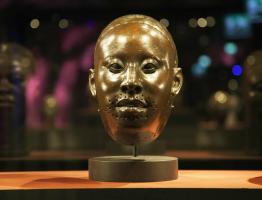All about Plato: biography, contributions and works of the Greek philosopher
Plato is one of the most important philosophers in Western culture. His influence has driven a current of thought known as "Platonism", the object of many interpretations throughout history. Who was Plato? What did he say and what did he do? What were the main contributions of him? What were his works?
Plato Biography

It is not known for sure where Plato was born. It is believed that he was born in Athens or Aegina between 426 and 347 BC. C. He grew up in an aristocratic family. His father was Ariston of Athens, a descendant of the kings Codro and Melanthus, and his mother was Perictione, from the family of Solon, an important political reformer. He had two brothers, Glaucón and Adimanto, and a sister, Potone.
His real name was Aristocles. Plato means "the one with the broad back" and it was a nickname that he apparently received from his gym teacher because of his physical appearance.
When his mother became widowed, she married Pirilampo, a friend of Pericles, who took care to provide him with the best education. He was a student of figures such as Theodore of Cyrene and Hermogenes, but he excelled in following Socrates, whom he took as his sole teacher from the moment he met him until his death. After this episode, which he apparently witnessed, he undertook several trips to Megara, Cyrene, Egypt and Archytas of Tarentum, fearing possible consequences.
Plato was the founder of the Academy of Athens, a school dedicated to the development of knowledge that was devoted to philosophy, rhetoric, mathematics, astronomy, and medicine. There he had Aristotle as the most outstanding of his students. The Academy operated for nine centuries, except for a few interruptions. After a life devoted to education, Plato died in his early 80s.
Contributions

In the Philosophy Dictionary by Nicola Abbagnano, three key elements of Platonism are exposed that, in some way, summarize the main contributions that the philosopher made and that continue to be a reference today. These are: the doctrine of ideas, the superiority of wisdom over knowledge and the defense of dialectics as a scientific method.
The theory of ideas or theory of forms
For Plato, from the philosophical point of view there are two realities: the sensible world and Ideas. The sensible world refers to the one that we can grasp through the senses and that is subject to mutations. Instead, Ideas are immutable and, therefore, true. Plato dismisses the value of the sensible world, since its changing nature distances it from the principle of Truth; this would be reduced to a copy of the Idea, to a "lie". Ideas are, then, the object of Platonic philosophy, true knowledge. From the opposition between the sensible world and the world of Ideas, the conception of Platonic dualism that runs through his work emerges.
Superiority of wisdom over knowledge
Nicola Abbagnano explains in her Dictionary that the principle of superiority of philosophy over knowledge refers to the political nature of philosophy. The objective of philosophy would be, in this sense, to make possible a social order based on justice, that not only regulates the relationships between subjects, but is capable of influencing the construction of the individual.
Dialectics as a scientific method
Plato defends dialectics as the scientific method par excellence, in the words of Nicola Abbagnano. What does dialectic mean in this context? In its original sense, dialectics refers to the reasoned discussion of two theses. Abbagnano defines Platonic dialectics as a "method of division" in which two or more people, through the system of questions and Socrates' responses, construct knowledge, in such a way that knowledge is not constructed individually but between subjects. In Plato, dialectics is understood as a method to achieve recognition of the first Idea, from which its species can be identified and structured.
Plato's works
Plato was a very prolific author. His work was presented in the form of dialogue, putting into practice the principle of the Socratic dialectical method. The works of the Greek philosopher have been arranged in many ways. One of the criteria has been according to his maturity stages.
Period of youth (393-389 a. C.)
Euthyphro or Of holiness. It relates a supposed meeting between the soothsayer Euthyphro and Socrates, in which they argued about the nature of the holy.
Apology to Socrates. The author exposes Socrates' arguments in the trial process that led to his death. Socrates would have defended himself against the accusations of trying to penetrate the divine mysteries, claiming that his teachings obeyed, rather, a command of the Elven god.
Crito or Duty. Through a dialogue between Crito and Socrates, Plato develops the question of obedience to the laws of the Republic, which he represents as an absolute duty.
Ion or Of poetry. Socrates and the rhapsodist Ion of Ephesus talk about poetry, interpretation and inspiration, questioning whether poetry can be considered, in fact, an art.
Lysis or Of friendship. A dialogue between Socrates, Lysis, Hypotals, Ctesippus, and Menexenes is the means by which Plato exposes his reflections on friendship, with particular emphasis on refuting previous theories about friendship. theme.
Charmids or Of wisdom. Socrates, Querefon, Critias and Carmines discuss the concept of wisdom, questioning the ideas around its perception.
Laques or Of value. In this particular dialogue, value is presented as a means through which Plato's true interest is discussed, which is the physical and moral education of children. The text represents a dialogue between Socrates, the elderly Melesias and Lysimachus and his sons, Aristides and Thucydides respectively, as well as the Athenian generals Nicias and Laques.
Protagoras or The sophists. This is quite a theatrical dialogue that deals with virtue or excellence, and exposes Plato's positions on the sophists, whom Socrates criticized. Among the characters mentioned are Socrates, Hippocrates, Alcibiades, Critias, Protagoras, Hippias, Prodicus and Callias.
Euthydemus or The disputer. Plato represents two conversations, one between Socrates and Criton, and another between Socrates, Euthydemus, and Dionisodorus. In this work, Plato refutes the eristics of the sophists and defends the Socratic dialectic.
Read also: Socrates' Apology
Transition period (388-385 a. C.)
Hippias major or What is beautiful? In the Greater Hippias, also known as First Hippias, Plato reflects on the notion of the beautiful through the dialogue between Socrates and Elis's Hippias. This text has been of vital importance in the development of aesthetics as a philosophical discipline.
Gorgias or Of Rhetoric. Socrates argues with Gorgias of Leontius, Pollux of Agrigento and Callicles of Athens. Through the exposition on the value and principles of the rhetoric or art of persuasion, Plato puts them in practice in developing the notions of the beautiful and the ugly, the just and the unjust, and ultimately the good within this dialogue.
Menéxenes or The funeral oration. These are two dialogues between Socrates and Mexénenes about citizens killed in combat. The first one represents a compliment and the second represents an exhortation.
Meno or Of virtue. Plato exposes, once again, his considerations on virtue, and questions whether it can be taught.
Cratyl or On the ownership of names. It is a dialogue between Socrates and Cratilo that presents the discussion about the nature of names and their meaning, which Socrates considers autonomous from human will.
Maturity period (385-371 BC) C.)
Phaedrus o Of beauty. Plato reflects on the science of beauty and the science of good. The experts say that in this text is the compendium of the learning of the teachers of him plus the germ of the best and most influential works of him, The Republic and The Laws. Some consider that this work is, rather, of the period of youth or transition.
Phaedo or Of the soul. Based on the last sequence of Socrates' life, the Phaedo reflects on the immortality of the soul, developing the theory of forms, reminiscence and metempsychosis.
The banquet or Of love. In this dialogue, also known as the symposium, Plato exposes his theories around the concept of Love. The discussion takes place at a banquet where diners debate Eros while eating and drinking.
The Republic. In the work the republic, Plato reviews the elements that, in his understanding, must make up the State, which involves the exposition of the concepts of fair and unfair. The importance of morality, justice and good in the construction of what is public and what is private converges in it. In this work the myth of the cave is exposed.
You can also read: Plato's Republic
Laws. It is the work that follows The Republic, where Plato tries to translate the ideals of the State into the sphere of public practice.
You may also like: Plato's Cave Myth.
Controversial dialogues (370-347 a. C.)
Parmenides or Of ideas. Plato himself seems to question here his theory of forms or Ideas.
Theaetetus or Of the science. The nature of knowing is discussed in this book. He wonders about the concept of perception and its relation to the process of knowledge.
Sophist or Of being. In this dialogue, Socrates is not the main voice, although he does appear as well. He ponders the definition of a sophist.
The politician or Of sovereignty. As in Sophist, Socrates is not a main character in the dialogue. He wonders about the definition of the politician, whom he sees as a man of science. But science, according to the philosopher, has two orders: the sciences of pure knowledge (speculative) and those of acts (practical). For the author, the politician responds to speculative sciences.
Philebus or Of pleasure. He starts from the question about the concept of human happiness and its nature, which is disputed between pleasure and wisdom.
Timaeus or Of the nature. It revolves around the origin of the universe, the structure of matter, and human nature.
Critias or Atlantis. Its main characters are Socrates, Timaeus, Critias and Hermocrates. He describes the war of Athens with Atlantis in pre-Hellenic times, which involves postulating the historical existence of this legendary land.
Apocryphal texts or texts of doubtful authorship
- Hippias minor, Of the lie or Second Hippias. There is a real dispute as to whether Plato wrote it or not, despite the fact that he was referred to by Aristotle. One of the reasons is the lack of clear distinction between the truthful man and the liar.
- Timaeus of Locres, of the soul of the world.
- The second Alcibiades or prayer.
- Hipparchus or from the love of profit.
- Rivals or philosophy.
- Epinomis or the philosopher.
- Teages or science.
- Minos.
- Clitophon.
- Axioco.
- Erixias.
- Of virtue.
- Fair enough.
- Definitions.
- Poetry
- Cards.
- Will.



